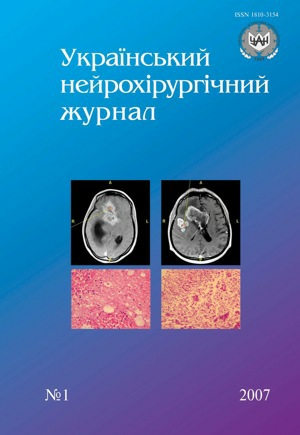Results of posterior and posterolateral decompressive approaches in thoraco-lumbar spine traumatic injures
DOI:
https://doi.org/10.25305/unj.130895Keywords:
spine, thoraco-lumbar, fractures, spinal decompression, spinal fixationAbstract
The retrospective analysis of medical records of 91 patients with traumatic thoracolumbar spine injury, whom operative decompression from posterior and posterolateral approaches was performed is done. The neurological status and neurological deficiency were identified according to Frankel scale, Denis and AO/ASIF classification fractures, methods of decompression and fixations were estimated. Indications for application of decompression-stabilization operations through posterior and lateroposterior approaches were the next: heavy and heaviest state of the injured person at spinal cord compression, spinal cord cross-section injury and at compression substratum localization behind and by side the spinal cord. For nervous structures decompression we applied: anulotaxis, laminectomy, facetectomy, corporectomy, hematomas and traumatic hydromas removal, and their combinations. The decompression stage should be finished by injured spine segment fixation in position of deformation correction. After the operation improvement of bladder and bowel functions was achieved at the majority of patients. Neurological deficit significantly regressed.
References
Ветрилэ С.Т., Кулешов А.А. Хирургическое лечение переломов грудного и поясничного отделов позвоночника с использованием современных технологий // Хирургия позвоночника.— 2004. — №3. — C.17–23.
Дзукаев Д.Н., Крылов В.В., Хорева Н.Е. и др. Передняя декомпрессия спинного мозга при операциях задним доступом — новые подходы в лечении больных с осложненной травмой грудопоясничного отдела позвоночника // 3-я конф. нейрохирургов России. — М., 2002. — С.196.
Перльмуттер О.А. Травма позвоночника и спинного мозга. — Н. Новгород, 2000. — 144 с.
Практическая нейрохирургия: Руководство для врачей / По ред. Б.В. Гайдара. — СПб: Гиппократ, 2002. — 647 с.
Andress H.J., Braun H., Helmberger T. et al. Long-term results after posterior fixation of thoracolumbar burst fractures // Injury. — 2002. — V.33, N4. — P.357–365.
Bedbrook G.M. Spinal injuries with tetraplegia and paraplegia // J. Bone Joint Surg. — 1979. — V.61-B. — P.267–284.
Been H.D., Poolman R.W., Ubags L.H. Clinical outcome and radiographic results after surgical treatment of post-traumatic thoracolumbar kyphosis following simple type A fractures // Eur. Spine J. — 2004. — V.13, N2. — P.101–107.
Boerger T.O., Limb D., Dickson R.A. Does ‘Canal Clearance’ affect neurological outcome after thoracolumbar burst fractures? //J. Bone Joint Surg. Br. — 2000. — V.82-B. — P.629–635.
Briem D., Lehmann W., Ruecker A.H. et al. Factors influencing the quality of life after burst fractures of the thoracolumbar transition //Arch. Orthop. Traum. Surg. — 2004. — V.9. — P.461–468.
Capen D.A. Classification of thoracolumbar fractures and posterior instrumentation for treatment of thoracolumbar fractures // Instr. Course Lect. — 1999. — V.48. — P.437–441.
Ching R.P., Tencer A.F., Anderson P.A., Daly C.H. Comparison of residual stability in thoracolumbar spine fractures using neutral zone measurements //J. Orthop. Res. — 2005. — V.13, N4. — P.533–541.
Chipman J.G., Deuser W.E., Beilman G.J. Early surgery for thoracolumbar spine injuries decreases complications // J. Trauma. — 2004. — V.56, N1. — P.52–57.
Cotton B.A., Pryor J.P., Chinwalla I. et al. Respiratory complications and mortality risk associated with thoracic spine injury // J. Trauma. — 2005. — V.59, N.6. — P.1400–1407.
Crutcher J.P. Jr., Anderson P.A., King H.A., Montesano P.X. Indirect spinal canal decompression in patients with thoracolumbar burst fractures treated by posterior distraction rods // J. Spinal Disord. — 1991. — V.4, N1. — P.39–48.
Dai L. Thoracic spine fractures //Chin. Med. Sci. J. — 2001. — V.16, N4. — P.227–230.
Danisa O.A., Shaffrey C.I., Jane J.A. et al. Surgical approaches for the correction of unstable thoracolumbar burst fractures: a retrospective analysis of treatment outcomes // J. Neurosurg. — 1995. — V.83. — P.977–983.
Eberl R., Kaminski A., Muller E.J., Muhr G. Importance of the cross-sectional area of the spinal canal in thoracolumbar and lumbar fractures. Is there any correlation between the degree of stenosis and neurological deficit? // Orthopade. — 2003. — V.32, N10. — P.859–864.
Fehlings M.G., Tator C.H. An evidence-based review of surgical decompression for acute spinal cord injury: rationale, indications, and timing based on experimental and clinical studies // Neurosurg. Focus. — 1999. — V.6, N1. — P.A1.
Fischer K., Ward J.C., Muller E.J. et al. Retrospective analysis of 848 fractures of the thoracolumbar spine // Spine J. — 2002. — V.2, N2, suppl.1. — P.6–7.
Fuentes S., Metellus P., Dufolr H., Grisoli F. Traumatic thoracic disc herniation // J. Neurosurg. Spine. — 2001. — V.95. — P.276.
Furderer S., Wenda K., Thiem N. et al. Traumatic intervertebral disc lesion-magnetic resonance imaging as a criterion for or against intervertebral fusion // Eur. Spine J. — 2001. — V.10, N2. — P.154–163.
Downloads
Published
How to Cite
Issue
Section
License
Copyright (c) 2007 E. I. Slihnko, A. Yu. Leontiyev, S. A. Panferov

This work is licensed under a Creative Commons Attribution 4.0 International License.
Ukrainian Neurosurgical Journal abides by the CREATIVE COMMONS copyright rights and permissions for open access journals.
Authors, who are published in this Journal, agree to the following conditions:
1. The authors reserve the right to authorship of the work and pass the first publication right of this work to the Journal under the terms of Creative Commons Attribution License, which allows others to freely distribute the published research with the obligatory reference to the authors of the original work and the first publication of the work in this Journal.
2. The authors have the right to conclude separate supplement agreements that relate to non-exclusive work distribution in the form of which it has been published by the Journal (for example, to upload the work to the online storage of the Journal or publish it as part of a monograph), provided that the reference to the first publication of the work in this Journal is included.









